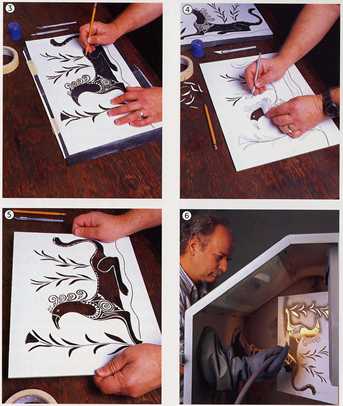|
How
do you etch glass, anyway?
The
principles of how to etch glass are easy to explain, and beginning
etching is easy to learn. You can complete projects quickly and
get a great feeling of accomplishment from beginning etching projects.
Glass etching is also one of the few crafts that is not only easy
to learn, but also will keep your interest for years! It has such
depth of technique that you could spend a lifetime learning to be
good at the more advanced methods.
|
Abrasive
glass etching is based on a couple of simple principles: 1)
Hard, sharp particles of abrasive material will chip the surface
of a piece of glass, causing it to look white or frosted,
when the abrasive is shot at the surface of the glass under
pressure, and 2) If you cover portions of the glass surface
with a material that resists the abrasive, you can produce
an etched design by leaving the glass exposed to the blast
where you want the etching to appear.
Photo
from Etched Glass: Techniques & Designs, by Norm
& Ruth Dobbins, used by permission. You can purchase this
book from our online
store in "Learn glass etching".
|
 |
(Note: The same
principle of selectively protecting portions of a glass surface
can be used with chemical etching, sometimes called “cream etching”,
because the etching chemical is thick and light in color, resembling
thick cream. This is an inexpensive way to get into glass etching
that is limited in effect, but fun for small projects. It is fully
described under “Chemical etching” on this site.)
The basic
procedure to etch glass is as follows:
1.Cover the surface of the glass with a self adhesive vinyl or rubber
blasting resist
2. Trace your design on the resist and cut it out with a stencil
knife. (See photo #3 above)
3. Remove the portions of the resist from the glass where you want
the etched design. (See photo #4 and #5 above)
4. Blast* the exposed areas of glass (see photo #6 above), then
remove the resist and clean - that’s all there is to it! (Note:
Carving and shading procedures are very different.)
Of course,
you will find it very important to investigate and pick the right
type of resist, the right abrasive, the right type of equipment,
the right blasting pressure, the right safety procedures, etc. That
is where our instructional materials on etching come in!
Details about
the exact blasting procedures, equipment, materials, safety, are
thoroughly covered in detail in our books, videos and in our hands-on
seminars.
|





